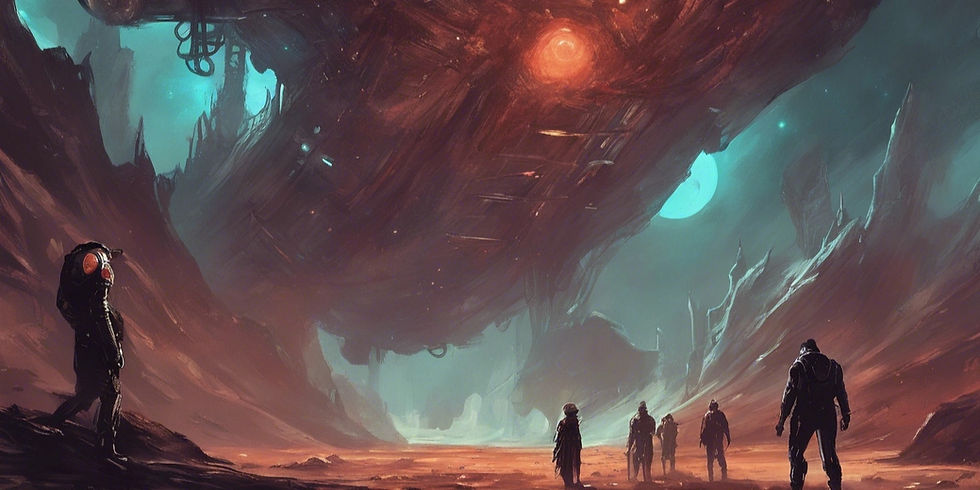Running Sci-Fi TTRPG Adventures
- Lorelis Eathalen

- Sep 26, 2024
- 4 min read
Updated: Dec 17, 2024

Cosmic adventures in a sci-fi TTRPG setting present GMs with both challenges and opportunities, offering vast storytelling potential. Here's how you can tap into the distinct elements of space to make your campaigns unforgettable.
The scale of space
One of the most striking aspects of cosmic campaigns is the sheer scale of the universe. Players aren't merely traversing kingdoms or continents—they’re crossing light-years, exploring star systems, and navigating distant worlds. Emphasize the isolation and danger of the void to create tension. Long travel between destinations becomes an opportunity to build suspense, introduce resource management (like fuel or oxygen), or offer moments of quiet reflection for the crew.
In space, help players feel the immensity and uncaring nature of the cosmos. Descriptions of eerie silence, malfunctioning technology, or encounters with derelict ships drifting in the void can heighten a sense of insignificance. This isolation is fertile ground for pushing your players into tough decisions and exploring their characters’ fears.
Alien worlds and environments
Space offers the chance to explore truly alien environments, and each planet or anomaly should feel genuinely otherworldly. Vary gravity, atmospheres, and physical laws to introduce unique challenges, making the players feel they’re walking on unfamiliar ground. Strange flora and fauna, ancient ruins, or mysterious technologies can spark curiosity and drive the story. Don't just focus on "what" the players find, but also "why" it exists. Unraveling these mysteries can be a core motivation in your cosmic campaigns.
Unique alien cultures
Populate your universe with rich, diverse alien species, each with their own customs, beliefs, and technologies. These differences can lead to compelling roleplay opportunities and moral dilemmas. Players may need to broker peace between warring factions or navigate the complexities of interacting with species that see the universe in ways vastly different from humans. Avoid simply making "humans in alien suits"; instead, craft cultures with deep lore, distinctive traditions, and conflicting values.
Interstellar politics
Political intrigue thrives in a vast, interconnected galaxy. Factions like trade guilds, corporate megacities, spacefaring empires, and rebellious insurgents offer fertile ground for multi-layered conflicts. Complex political systems, territorial disputes over resource-rich planets, and corporate espionage can drive your campaign’s overarching plot. Players might find themselves navigating delicate diplomacy where their decisions can lead to wars, alliances, or upheaval. Interstellar politics provide storytelling opportunities that go beyond combat, placing players in the heart of galactic power struggles.
Technological wonders and dangers
Technology is both a gift and a curse in sci-fi settings. Advanced technology can be an invaluable asset—teleportation systems, AI companions, or starships with faster-than-light travel—but it can also introduce unpredictable dangers. Rogue AI, malfunctioning systems, or catastrophic technology failures can create high-stakes tension. Integrating technological hazards into your adventures ensures that space remains as perilous as it is wondrous, constantly testing the ingenuity and adaptability of your players.
Cosmic horror
The vastness of space is fertile ground for cosmic horror. Unknowable forces, ancient alien intelligences, or mysterious phenomena lurking in the void can bring a sense of dread and awe. Let your players confront the terrifying unknown—strange signals from deep space, star systems where the laws of physics unravel, or encounters with entities that defy comprehension. The cosmic unknown adds an edge of existential fear that’s perfect for sci-fi settings.
By blending interstellar politics, alien cultures, technological marvels, and the dark mysteries of the cosmos, you can craft a campaign that turns the vastness of space into a playground of adventure—and danger.
Whispers from other Dimensions
Great GM shares tips for running a sci-fi RPGs, focusing on player expectations like science, aliens, and space travel. Establishing a campaign's tone is crucial for plot development, while balancing technology and character skills poses challenges for engaging gameplay.
AltHaven explores key differences between running sci-fi and fantasy RPGs. The hosts emphasize understanding player expectations, establishing tone, managing technology versus historical context, and the importance of zero sessions to set campaign parameters effectively.
Dicegeeks explain how Sci-Fi TTRPGs benefit from dungeon-like environments. It tries to sell a book designed to help GMs create engaging facilities using random tables for locations, encounters, and more. The ideas however, are relevant to the topic at hand.
Nerdarchy also explores running sci-fi RPGs versus fantasy games, highlighting similarities like character goals and party dynamics. It discusses session prep, the role of technology in sci-fi, and the importance of adapting traditional adventure structures to different genres.
Legion of Myth, after a 5min introduction, shares preferences for optimistic, military, and hard sci-fi. It later explores creating expansive sci-fi settings, urging GMs to avoid clichéd planets and to embrace diverse, human-centric stories.
They continue on this next video, (1h long) with a discussion on world-building in vast sci-fi universes, offering tips and strategies for creating immersive settings. They emphasize using sensory details, player engagement, and taking notes for consistency.
This one discusses the best RPG systems for capturing the spirit of sc-fi. Participants highlight "Traveler", "Star Frontiers", "D6 Star Wars" and "Rifts", focusing on ease of use, thematic elements, and managing technology. They also discuss player engagement and strategy.
Crucibles to try out in your next sci-fi TTRPG adventure session
Long Space Travel: Start with a journey through space. Track resources like fuel and oxygen to create tension and excitement.
Unique Planet: Design an alien world with strange weather and unusual plants. Include a mystery, like ancient ruins, for players to uncover.
Diverse Alien Cultures: Introduce different alien species with their own customs. Create a situation where players must negotiate peace between two conflicting groups.
Political Conflict: Add a storyline involving rival factions fighting for control of a valuable resource. Let players decide how to navigate the politics.
Tech Problems: Include advanced technology that can malfunction, like an AI that goes rogue. This adds unpredictability and keeps players alert.
These straightforward ideas will help make your sci-fi sessions more engaging and immersive!



Comentarios